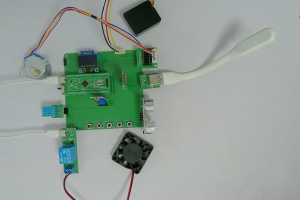设计说明书
总字数:20000+
摘要
随着人们对学习和工作环境舒适度、健康性要求的不断提高,书桌作为日常学习和工作的重要载体,其智能化升级逐渐受到关注。传统书桌功能单一,仅能提供放置物品的平面,无法满足人们对高度调节、照明适配、健康监测等方面的需求,长期使用易导致坐姿问题、视觉疲劳及久坐危害等。
基于 STM32F103C8T6 单片机的智能书桌,整合了步进电机(模拟高度调节)、HC-R04 超声波传感器、5516 光照检测模块、DHT11 温湿度传感器、CN-TTS 语音模块、按键、OLED 显示屏、ESP8266 WIFI 模块及执行设备(灯光、风扇)等,实现了书桌的智能化调节与监测。系统核心功能包括:通过按键调节书桌高度,监测到人离开时自动降低书桌;借助 HC-R04 检测台灯到人的距离,距离小于设置最小值时,通过 CN-TTS 进行坐姿问题语音提醒;利用 5516 检测光照值,当距离小于设置最大值(有人在台灯前)时,若光照小于设置最大值则打开灯光,在最大值和最小值之间时根据光照值自动调节亮度,小于设置最小值时调整为最大亮度;通过 DHT11 检测温湿度,温度高于设置最大值时开启风扇降温;支持通过按键设置工作时间,计时超过设置时间后进行语音提醒以防止久坐;可通过按键设置各阈值及手动调节灯亮度;OLED 显示屏实时显示各项数据;通过 ESP8266 将数据发送到手机端,手机端可设置各阈值,还能远程控制书桌高度、调节灯亮度及控制风扇开关。
该系统的实现,有效提升了书桌的智能化水平,为用户营造了健康、舒适的学习和工作环境,减少了不良使用习惯带来的健康风险,同时为同类智能家具设备的研发提供了参考,具有较高的实际应用价值。
关键词:STM32F103C8T6;智能书桌;传感器;自动调节;远程控制;健康监测
ABSTRACT
With the increasing requirements for comfort and health in learning and working environments, the desk, as an important carrier for daily study and work, has gradually attracted attention for its intelligent upgrading. Traditional desks have single functions, only providing a flat surface for placing items, and cannot meet people’s needs in height adjustment, lighting adaptation, health monitoring, etc. Long-term use can easily lead to sitting posture problems, visual fatigue, and sedentary hazards.
The intelligent desk based on the STM32F103C8T6 microcontroller integrates stepping motors (simulating height adjustment), HC-R04 ultrasonic sensors, 5516 light detection modules, DHT11 temperature and humidity sensors, CN-TTS voice modules, buttons, OLED displays, ESP8266 WIFI modules, and executive devices (lights, fans), realizing intelligent adjustment and monitoring of the desk. The core functions of the system include: adjusting the desk height through buttons, automatically lowering the desk when detecting that a person leaves; using HC-R04 to detect the distance from the desk lamp to the person, and when the distance is less than the set minimum value, using CN-TTS to give a voice reminder for sitting posture problems; using 5516 to detect the light value, and when the distance is less than the set maximum value (someone is in front of the desk lamp), if the light is less than the set maximum value, the light is turned on; when the light is between the maximum and minimum values, the brightness is automatically adjusted according to the light value; when the light is less than the set minimum value, it is adjusted to the maximum brightness; detecting temperature and humidity through DHT11, and turning on the fan to cool down when the temperature is higher than the set maximum value; supporting setting working time through buttons, and giving a voice reminder after the timing exceeds the set time to prevent sitting for a long time; allowing setting various thresholds and manually adjusting the lamp brightness through buttons; the OLED display showing various data in real-time; sending data to the mobile phone through ESP8266, and the mobile phone can set various thresholds, as well as remotely control the desk height, adjust the lamp brightness, and control the fan switch.
The implementation of this system effectively improves the intelligence level of the desk, creates a healthy and comfortable learning and working environment for users, reduces health risks caused by bad usage habits, and provides a reference for the research and development of similar intelligent furniture equipment, with high practical application value.
Keywords: STM32F103C8T6; Intelligent desk; Sensor; Automatic adjustment; Remote control; Health monitoring
目录
第 1 章 绪论
1.1 研究的目的及意义
1.2 国内外发展情况
1.3 本文主要研究内容
第2章 设计思路与方案论证
2.1 主要元器件选择
2.1.1 主控芯片选择
2.1.2 超声波传感器选择
2.1.3 光照检测模块选择
2.1.4 温湿度传感器选择
2.1.5 语音模块选择
2.1.6 WIFI 模块选择
2.1.7 显示模块选择
2.1.8 按键模块选择
2.2整体设计方案
第 3 章 硬件设计
3.1 主控电路模块
3.2 超声波传感器电路
3.3 光照检测模块电路
3.4 温湿度传感器电路
3.5 步进电机驱动电路
3.6 语音模块电路
3.7 显示模块电路
3.8 WIFI 模块电路
3.9 按键模块电路
第4章 系统程序设计
4.1 编程软件介绍
4.2 系统主流程设计
4.3 OLED显示子流程设计
4.4 独立按键子流程设计
4.5 温湿度检测模块子流程设计
4.6 步进电机子流程设计
4.7 ADC模数转换子流程设计
4.8 语音播报模块子流程设计
4.9 WiFi模块子流程设计
第 5 章 实物测试
5.1 整体实物测试
5.2 超声波传感器功能测试
5.3 光照检测模块功能测试
5.4 温湿度传感器功能测试
5.5语音模块功能测试
5.6 WIFI 模块功能测试
5.7 按键设置与显示功能测试
第 6 章 总结与展望
6.1 总结
6.2 展望
致谢
参考文献
附录
附录一:原理图
附录二:PCB
附录三:主程序
购买后可查看具体内容!

